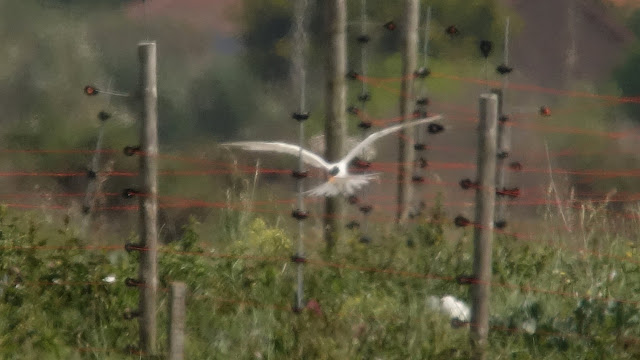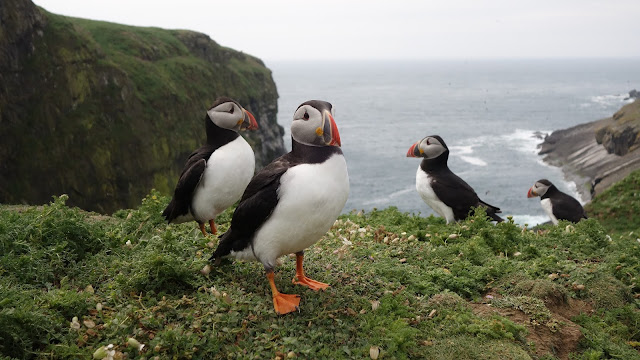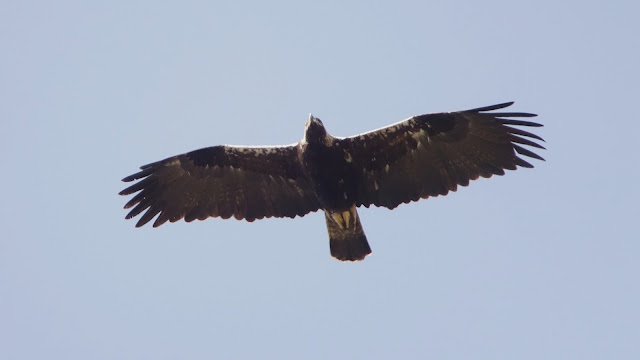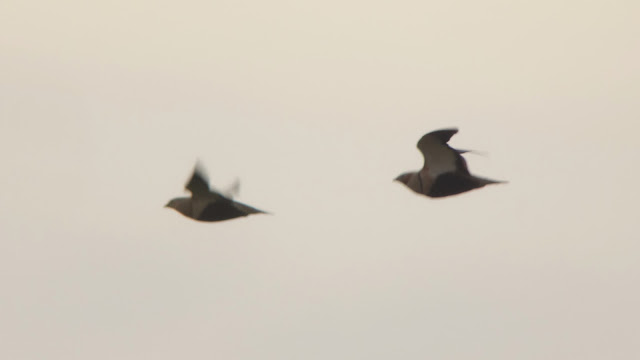If Extremadura was famous for something more than its steppe
habitats, it would be its wealth of raptors that make it world famous. With
around half of the world population existing within Spain, and one of the
highest densities, Extremadura is renowned for its populations of European
Black Vulture. Together with good populations of the endemic Spanish
Imperial (Iberian) Eagle, among a wide range of raptor species, it makes
Extremadura a must visit destination for Raptorholics.
It is the Spanish
Imperial Eagle which I was most hoping to connect with and over the course
of the week, we were well and truly spoilt for the species. We managed to see
the species on almost every day, with superb views from our very own balcony,
with regular views of at least 3 overhead. It was great to get to grips with
this species, often at close range as they soared along the ridgeline above.
Most commonly seen was this adult bird, which we very quickly saw has a
satellite transmitter on its back. It would be very interesting to see who was
tracking it and where it has been!
Also commonly seen was this immature bird (4cy) with a very
interesting mixture of juvenile and adult plumage. This also happened to be a
very vocal individual, often scrapping with (presumably) its parent. Its low,
and fairly quiet ‘barking’ call was often heard while enjoying our lunch on the
balcony! It also happened to be one of the last birds I saw when we were
packing the car to leave!
As well as getting a bit of gip from its younger companion,
a number of the more common species also chose the opportunity to mob the
larger Bird of Prey, with this Black Kite giving a fair bit of effort for a few
minutes.
Like the Spanish Eagle,
Black Vultures were seen regularly throughout the trip, in many habitats. They
were commonly seen from our accommodation, over the plains, sitting among
livestock and around breeding sites within Monfragüe national park. Some
great views were had with patience, including one a number sitting in fields on
the Santa Marta loop, looking rather like the grim reaper among the sheep and
cattle.

The Montagu’s Harrier is one of my favourite raptor species,
their light elegant flight, stunning plumage and rarity (particularly in the
UK) all add to their appeal. It is always a pleasure then to see good numbers
in the Iberian peninsula, where they are significantly more common than my
homeland. As with any extensive area of habitat, views tended to be distant,
however we also managed a number of close flybys, often from the car while
driving past. Later in the trip however we dropped into a site well known for
large gatherings of the species, and as we did were lucky to see a ‘flock’ of
Montagu’s Harriers perching on fence posts next to the road a little further
up. With a bit of curb crawling, excellent views were had from the comfort of
our car seats! The female birds in particular were rather showy, happily sitting
on the fence posts until another birder pulled up in a car behind us, and
proceeded to get out!! And that was the end of that!


The male bird on the other hand proved more difficult, not
being helped by an ongoing territorial dispute which had him chasing a rival
male every couple of minutes. He did join the females on the posts briefly, but
was mostly seen in flight. It was nice to watch sky-dancing Montagu’s Harriers
again, something I haven’t seen for a couple of years.
Although nowhere near as common as I have seen elsewhere in
Iberia (probably due to their positions close to raptors flyways), good numbers
of both Short-toed Eagle were seen, with just under daily sightings. We managed
our best views from the balcony of our accommodation, where 2 birds often
patrolled the ridgeline.
Booted Eagle in my opinion are one of the more striking
birds of prey in Europe. Being smaller and less imposing than their larger
Eagle cousins it is easy to not be so impressed. Many of the birds in Iberia
however are examples of the pale morph, with its striking contrast between
white underwings and body, black flight feathers and warm brown head and
mantle, this creates one stunning bird. All 3 colour morphs were seen; pale,
intermediate and dark, allowing for some good scrutiny of their variances in
plumage.

Being so close to Trujillo, and the nestbox scheme on the
Santa Marta loop, another Raptor commonly seen was Lesser Kestrel. The smaller,
lighter and more agile relative of the Kestrel. Many good views were had as the
birds held territory around ‘their box’. A visit to the Trujillo bullring in
the heat of the day meant that the birds were hunting in the fields around the
town rather than perched near their nests, however good views were had of them
hunting above the town centre as we explored the winding streets of an old
Mediterranean town.

Although it is easy to highlight the rarer raptors, it is
hard not to ignore the more abundant species. Species like Griffon Vulture and
Black Kite can be regarded as two of the most commonly seen species of the
trip, however the spectacle of seeing so many large raptors in the sky is
rather awe inspiring. Even this far inland, far away from the migration
hotspots of Tarifa and Gibraltar rock, large kettles of both species were seen
almost daily. Combined with mixed White Storks and a various assortments of
rarer raptor species, it was always a sight to behold.
Excellent views were had of both, including some phenomenal
views of Griffon Vultures within Monfragüe, perched at their cliff face nesting
sites.
Despite still being common, it is poignant to end on a note
that even now, the populations of many of these species have declined. As with
any developing country, space for the species is gradually being restricted and
as land use change occurs, the resulting population levels suffer. With the use
of the veterinary drug Diclofenac still being discussed for use in Europ, it is worth looking at the effect that is has had in Asia. Having spent
some time in India earlier this year (more in an upcoming blog post), it was
shocking to see the extent of the damage to the vulture population that the
drug had had, with a handful of individuals left in a tiny relic population. It
is not difficult to imagine a similar outcome here in Europe.
Here is hoping that the right decision is made, and efforts
are made to protect the superb Raptor species present in Iberia.

































